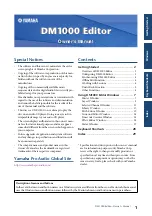Reviews:
No comments
Related manuals for Disk Array Administrator

PowerShot SD10 Digital ELPH
Brand: Canon Pages: 124

DM 1000
Brand: Yamaha Pages: 30

NioWatch
Brand: Barco Pages: 22

LexPrint
Brand: Lexmark Pages: 20

WiFi-Doc Client for iOS
Brand: Mitsubishi Pages: 10

INDeX Agent Assist
Brand: Avaya Pages: 12

INSIGHT -
Brand: FARONICS Pages: 43

Series 60
Brand: Nokia Pages: 84

Sun GlassFish EnterpriseServer v3 Prelude
Brand: Sun Microsystems Pages: 48

Sun StorEdge Availability Suite 3.2
Brand: Sun Microsystems Pages: 52

OS 2.x
Brand: SonicWALL Pages: 20

Y-C
Brand: COMPRO Pages: 8

MOBILE SECURITY 6 FOR ANDROID
Brand: F-SECURE Pages: 22

Network HotSync
Brand: 3Com Pages: 38

Remote Annex
Brand: Bay Networks Pages: 90

COLFUSION MX 7-GETTING STARTED BUILDING COLDFUSION...
Brand: MACROMEDIA Pages: 152

PHOTOIMPACT MENU PLUG-IN
Brand: Ulead Pages: 11

FLASH REMOTING MX-USING FLASH REMOTING FOR FLASH MX 2004 ACTIONSCRIPT...
Brand: MACROMEDIA Pages: 180

















